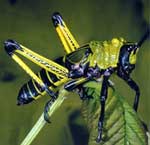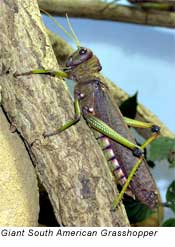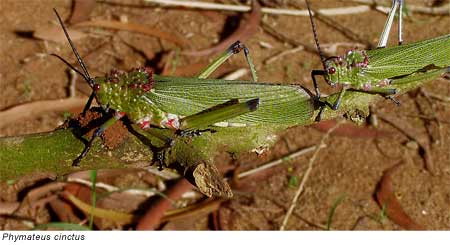|

 Tough Skinned: Grasshoppers have a tough outer skin which affords them great protection.
They vary extensively in color, depending largely on local environments.
Dry arid environments tend to produce more species which are tan
to brown in color, while moist, succulent terrain will have greener
grasshoppers. Many species will start a season green, however, and
turn brown as the summer lags on into fall. Tough Skinned: Grasshoppers have a tough outer skin which affords them great protection.
They vary extensively in color, depending largely on local environments.
Dry arid environments tend to produce more species which are tan
to brown in color, while moist, succulent terrain will have greener
grasshoppers. Many species will start a season green, however, and
turn brown as the summer lags on into fall.

 The Piano Man: Most grasshoppers are great songsters. Males will use sound during
courtship, and their voices are so distinctive that many people
are able to identify species by their song! Shorthorned species
are only able to sing by rubbing various body parts together so
they are really only able to "chirp". However, both females
and males will use sound throughout the year. It is believed their
song is used to communicate food locations, mating seasons and the
general state of local populations. The Piano Man: Most grasshoppers are great songsters. Males will use sound during
courtship, and their voices are so distinctive that many people
are able to identify species by their song! Shorthorned species
are only able to sing by rubbing various body parts together so
they are really only able to "chirp". However, both females
and males will use sound throughout the year. It is believed their
song is used to communicate food locations, mating seasons and the
general state of local populations.
Insect Email: Grasshoppers have well developed ears which enable their sound
to find the right target from great distances. It is clear their
use of sound keeps them close together, which is essential for species
development and survival.
Plagues: Grasshoppers are worst known for the damage they do while eating.
They have strong chewing mouth parts along with ferocious appetites,
and have been known to clear acres of crops, wild terrain and urban
landscaping. At times they appear to eat whatever is in their path.
Although common in the United States, a relative of the grasshopper
-- the locust -- is a devastating force in other parts of the world,
where they can descend in enormous clouds and wreak havoc on crops
within only a few minutes.

Here's Spit in Your Eye: Although they're typically not "biters", they do have
the ability to chew on fingertips, when captured. Their main defense,
when captured, is to produce a foul, sticky brown "spit"
in alarm or fear. While not toxic, the spit is usually enough to
cause capturing hands (or mouths) to release the grasshopper in
surprise.
All text is available under the terms
of the GNU Free Documentation License
|